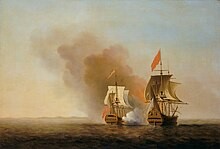Article III. Three British Wars with Funny Names and Some Importance
THE ANSON EXPEDITION:

The success of the Porto Bello operation led the British, in September, 1740, to send a squadron under Commodore George Anson to attack Spain’s possessions in the Pacific. Before they reached the Pacific, numerous men had died from disease, and they were in no shape to launch any sort of attack. [See The Wager: A Tale of Shipwreck, Mutiny, and Murder, by David Grann, Random House, 2023]. The ill-fated Wager suffered terrible storms, shipwreck, marooning, castaway mutiny, and several murders before the factions of the crew separately returned to the mother country for a reckoning.
Anson—in the lead ship–reassembled his force in the Juan Fernández Islands, allowing them to recuperate before he moved up the Chilean coast, raiding the small town of Paita. He reached Acapulco too late to intercept the yearly Manila galleon, which had been one of the principal objectives of the expedition. He retreated across the Pacific, running into a storm that forced him to dock for repairs in Canton. After this he tried again the following year to intercept the Manila galleon. He accomplished that on June 20, 1743 off Cape Espiritu Santo, capturing more than a million gold coins.
Anson sailed home, arriving in London more than three and a half years after he had set out, having circumnavigated the globe then circumnavigated the globe in the HMS Centur-ion [1740–1744], in the process. Less than a tenth of his forces had survived the expedition. Anson’s achievements helped establish his name and wealth in Britain, leading to his appointment as First Lord of the Admiralty.
Siege of Saint Augustine [1740]:
In 1740, the inhabitants of Georgia launched an overland attack on the fortified city of St. Augustine in Florida, supported by a British naval blockade, but were repelled. The British forces led by James Oglethorpe, the Governor of Georgia, besieged St. Augustine for over a month before retreating, and abandoned their artillery in the process. The failure of the Royal Navy blockade to prevent supplies reaching the settlement was a crucial factor in the collapse of the siege. Ogle-thorpe began preparing Georgia for an expected Spanish assault. The Battle of Bloody Mose, where the Spanish and free black forces repelled Oglethorpe’s forces at Fort Mose, was also a part of the War of Jenkins’ Ear.
When war broke out in 1739, both Britain and Spain expected that France would join the war on the Spanish side. This played a large role in the tactical calculations of the British. If the Spanish and French were to operate together, they would have a superiority of ninety ships of the line. In 1740, there was an invasion scare when it was believed that a French fleet at Brest and a Spanish fleet at Ferrol were about to combine and launch an invasion of England. Although this proved not to be the case, the British kept the bulk of their naval and land forces in southern England to act as a deterrent.
Many in the British government were afraid to launch a major offensive against the Spanish, for fear that a major British victory would draw France into the war to protect the balance of power. Finally, in 1742, the Spanish launched an attempt to seize the British colony of Georgia. Manuel de Montiano commanded 2,000 troops, who were landed on St. Simons Island off the coast. British General Oglethorpe rallied the local forces and defeated the Spanish regulars at Bloody Marsh and Gully Hole Creek, forcing them to withdraw. Border clashes between the colonies of Florida and Georgia continued for the next few years, but neither Spain nor Britain undertook offensive operations on the North American mainland.
The official position of Parliament about Jenkins’ testimony is that “detailed records of the proceedings of the Committee of the whole House do not exist for this period” and therefore that “the evidence from parliamentary records is inconclusive”.
off Chile, marauded coastal areas, capturing Spanish treasure along the way.
Attempts to seize Cuba in December, 1741 and raids along the then circumnavigated the globe in the HMS Centurion (1740–1744), coast were largely fruitless, resulting in heavy British casualties. Gradually the war overseas petered out into desultory forays against Spanish shipping and ineffectual attempts to isolate Spain from her colonies before becoming enveloped and overshadowed by hostilities in Europe [War of the Austrian Succession, 1740–1748] in which Britain, by means of mercenary forces, supported Austria against France–who had joined Spain and her German allies.
While in its altered, Continental dimension, the war enabled Britain to contain threatening Bourbon expansionism in key strategic areas abroad during the period 1742–1748, overseas it failed to achieve the initially anticipated sweeping victory over Spain. Small-scale Anglo-Spanish clashes in Caribbean and Mediterranean waters produced little monetary or strategic gain, clearly indicating that naval action was not the solution to Britain’s commercial grievances at this time, nor the key to much-needed political stability.
Florida was under colonial rule by Spain from the 16th-19th centuries and briefly by Great Britain during the 18th century [1763–1783]. Neither Spain nor Britain maintained a large military or civilian population. Florida had become a burden to Spain, which could not afford to send settlers or man garrisons; so, Madrid decided to cede the territory to the United States in exchange for settling the boundary dispute along the Sabine River in Spanish Texas. The Treaty of Aix-la-Chappelle in 1748 returned all colonial claims to previous owners, and the two nations unofficially agreed upon the St. Johns River as the boundary between Georgia and Florida. It became a territory of the United States in 1821.
The colony of Georgia had been an issue of contention between Britain and Spain since its foundation in 1733. Spain claimed the territory for its own colony of Florida and disputed what was regarded as an illegal occupation by the British settlers. With no gold or silver in the region, Spain regarded Florida–and particularly the heavily fortified town of St. Augustine–primarily as a buffer between its more prosperous colonies to the south and west and several newly established rival European colonies to the north.
By mid-1742, the War of the Austrian Succession had broken out in Europe and subsumed the War of Jenkin’s Ear. Principally fought by Prussia and Austria over possession of Silesia, the war soon engulfed most of the major powers of Europe, who joined two competing alliances. The scale of this new war dwarfed any of the fighting in the Americas and drew Britain and Spain’s attention back to operations on the European continent. The return of Vernon’s fleet in 1742 marked the end of major offensive operations in the War of Jenkins’ Ear. France entered the war in 1744, emphasizing the European theatre and planning an ambitious invasion of Britain. While it ultimately failed, the threat persuaded British policymakers of the dangers of sending significant forces to the Americas which might be needed at home.
The war involved privateering by both sides. Captain George Anson captured a very valuable Manila galleon, but this was more than offset by the numerous Spanish privateering attacks on British shipping along the transatlantic triangular trade route. They seized hundreds of British ships, looting their goods and slaves, and operated with virtual impunity in the West Indies; they were also active in European waters. The Spanish convoys proved almost unstoppable. During the Austrian phase of the war, the British fleet attacked poorly protected French merchantmen instead.
Moreover, the war put an end to the British smuggling, and the Spanish fleet was able to dispatch three treasure convoys to Europe during the war and off-balance the British squadron in Jamaica. The issue of the asiento was not mentioned in the treaty, as its importance had lessened for both nations.
George Anson’s expedition to the Southeast Pacific led the Spanish authorities in Lima and Santiago to advance the position of the Spanish Empire in the area. Forts were thus built in the Juan Fernández Islands and the Chonos Archipelago in 1749 and 1750. Admiral George Anson went on to win more naval victories. During the ensuing War of the Austrian Succession, he captured an entire French fleet. His historians agree that Anson’s greatest impact was as an administrator. He professionalized the naval service, established a permanent marine corps, and strove to correct the many faults which led to the shipwreck and mutiny of the Wager and the subsequent mutiny. Adm. Anson was hailed in his time as the “Father of the British Navy” and is still regarded as such by many historians and the British public of today.

